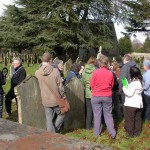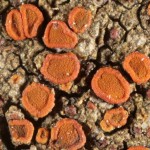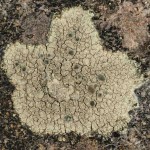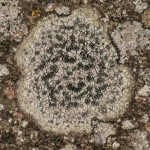On Saturday 12 March, a collaborative walk, between the Reading and District Natural History Society and the Friends of Newtown Road Cemetery, was led by James Wearn (Recorder of Lichens for the Society) within the grounds of the newly re-managed Newtown Road Cemetery in Newbury. The older of the two large cemeteries in the town, the Newtown Road site was closed in 2000 for health and safety reasons. Nevertheless, during the last year, close interaction between the Friends, the Town Council and specialist wildlife recorders has allowed significant progress towards the re-opening of the site to the public and creation of a Wildlife Management Plan.
Elizabeth Capewell (from the Friends) gave an introductory talk about the historical importance of the site and provided absorbing information on the historically important figures buried therein. James fascinated the group with the intricacies and peculiarities of lichen ecology. He explained that lichens are formed from a partnership between two organisms: a fungal partner provides shelter for the algae that live within it (allowing the latter to live in harsh, dry environments) while, in return, the fungus receives nutrition from the photosynthetic algal cells. The group was shown examples of the range of lichen forms that can result from this interaction – from tiny crusts on walls to metre-long ‘bushy’ forms found hanging from trees in damp forests. The importance of lichens, for example, as natural indicators of pollution levels and as food for insects (especially moth larvae), was highlighted, as well as the critical role of careful site management in maintaining the diversity of these intriguing little organisms.
To date, 38 species have been recorded in the cemetery. Of particular note, Caloplaca crenularia, characterised by its bright orange fruiting discs (technically apothecia, or, if one prefers, ‘jam tarts’!) is present in only one location in the cemetery: on the top and base of a single, large chest tomb, and only on the sheltered region nearest to the boundary wall, although in some abundance on the tomb. The tops of chest tombs are frequently the most interesting habitats because their horizontal surfaces are often slow to dry out. This distinctive species is listed as ‘occasional’ in Berkshire and has a distinctly western distribution in England. In 1986, it was recorded by Francis Rose at Woolton Hill, approximately four miles southwest of Newbury (just over the border in Hampshire).
Another highlight was the greenish-yellow Lecanora sulphurea, a species found on nutrient-enriched acid rocks and walls. Interestingly, L. sulphurea often parasitizes Lecanora or Tephromela species and was observed frequently, growing over these lichens. Bilimbia sabuletorum, beyond having a wonderful name, is restricted in the cemetery to growing on mosses on a single window ledge of the chapel. It has a scurfy greyish body with convex brown fruits. If this ledge is scraped clean then this lichen will disappear from the site – which just shows how insensitive management leads to biodiversity loss!
Primroses and Sweet Violets were flowering in the cemetery and sharp-eyed botanists spotted the leaves of Meadow Saxifrage. The warm early-spring sunshine had tempted a few butterflies out of hibernation and single specimens of Brimstone, Peacock and Small Tortoiseshell were recorded.
Pictures by Malcolm Storey and Jan Haseler




